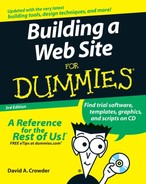Achieving Unity: What Makes a Site Truly a Site
No matter what technology you use to build your site, you can make it a great one — or a real loser. You can base it on HTML (HyperText Markup Language), CFML (ColdFusion Markup Language), ASP (Active Server Pages), DHTML (Dynamic HTML), AJAX (Asynchronous JavaScript and XML), or any other alphabetical wonders you care to work with. It may sound blasphemous to a world that’s used to worshipping at the altars of the latest high-tech advances, but the real secret to making a Web site work is simple human insight.
Determining the underlying theme
Long before you set out to choose background colors or font types or graphical styles, you must get a solid grasp on the theme of your site. The theme is the unifying idea on which everything else on your site rests. Sometimes, the theme is simple and obvious. For a corporate recruiting site, the theme is why this company is the best place to work. For a genealogical site, the theme is the history of a single family and its offshoots.
Other times, the theme is a bit more complex. For an e-commerce site, you may choose a theme of great prices and saving money. If you’re aiming for a different market, however, you may charge high prices and base your theme on either higher-quality products or just plain snob appeal. The underlying mechanics of both sites may well be identical — navigational methods, orderprocessing systems, and so on — but the sites’ editorial content and graphical look and feel would be totally different.
Your low-cost bargain site may, for example, have bright and simple graphics that show a happy-go-lucky cartoon character using scissors to whack dollars in half. The high-roller site, on the other hand, would do well with richer, deeper colors. Although both sites, as in any selling situation, need to display photographs of their products, the higher-priced site is most likely to appeal to its intended audience with photographs of well-dressed people using its products in sophisticated settings.
Setting limits on content
If you’ve ever participated in newsgroups or mailings lists, you know how annoying it is when someone gets way off topic. There you are on alt.citrus.cosmetics, trying to find out the latest tips for using orange juice as a hair conditioner, and some guy starts blathering about the high price of gasoline or which cell phone company has the best roaming plan. It’s usually not very long before someone else reminds him that’s not what he’s there for.
When it comes to the material on your site, unless you’re part of a Web development team, you alone are responsible for staying on topic. This is the flip side of determining your theme — determining where to stop and what not to cover.
Take an e-commerce site devoted to personal electronics, for example. You’d need to decide whether to sell the entire spectrum of available devices or to target a specific niche, such as MP3 players or digital cameras. For a religious site, you may need to choose among covering the activities of your local church, the wider issue of the tenets of the sect to which it belongs, or the broadest range of world religious beliefs. If you don’t know in advance what you’re going to do — and not do — you’re really hampering yourself. Designing a Web site is much easier if you know what specific parameters your efforts must meet.
